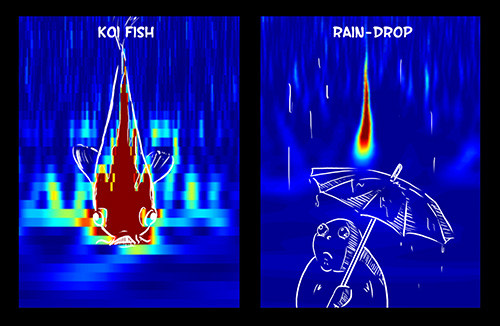Tag archives: gravitational waves
The beauty of gravitational waves
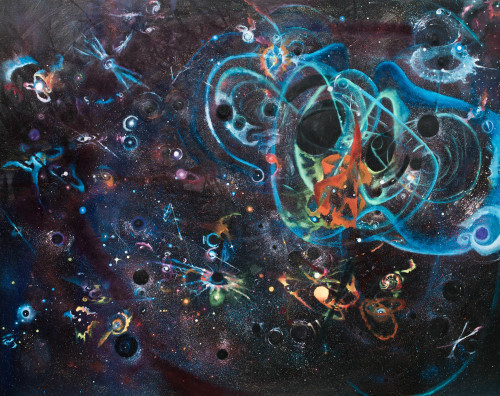
Science meets art – this painting by Penelope Cowley will be unveiled at Cardiff University’s school of physics and astronomy on 25 November.
By Matin Durrani
A new painting by Welsh artist Penelope Cowley is the latest attempt to bring art and science together. Set to be unveiled on Friday 25 November at Cardiff University’s school of physics and astronomy, the 1.2 × 1.5 m picture was inspired by the recent detection of gravitational waves by the LIGO collaboration.
According to the university, the oil painting “combines a visualization of data taken from the equipment used to detect the first gravitational waves…with an imagination of some of the celestial bodies that are responsible for creating these waves, such as binary black holes and neutron stars”.
View all posts by this author | View this author's profile
Cosmic messengers and the rise of neutrino astronomy
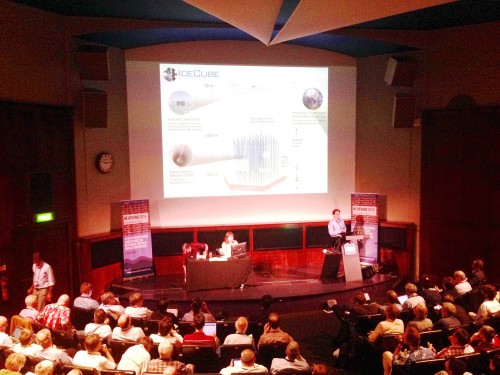
Cool operator: Marek Kowalski talking about IceCube at the Neutrino 2016 conference. (Courtesy: Tushna Commissariat)
By Tushna Commissariat at the Royal Geographical Society in London
“There are still many things to be studied in neutrinos,” said 2015 Nobel laureate Takaaki Kajita at the first talk of the Neutrino 2016 conference that began in London today. I couldn’t help but notice that his statement rang very true, as the day’s talks touched on everything from high-energy neutrinos to dark-matter searches to monitoring nuclear reactors. This year, more than 700 physicists from all over the world are attending the week-long conference, which is taking place at the historic Royal Geographical Society in London.
George Smoot on mapping the universe with gravity
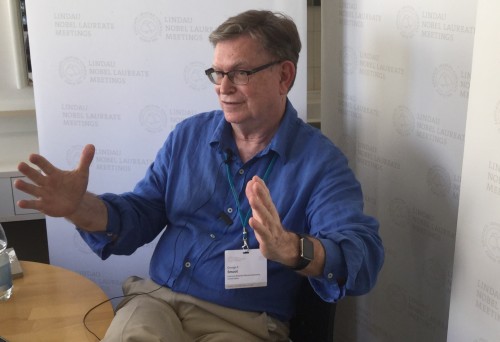
Measuring the universe: George Smoot enthuses about gravitational waves.
By Hamish Johnston at the Lindau Nobel Laureate Meeting in Germany
Yesterday I was in a fantastic session with George Smoot, who shared the 2006 Nobel Prize for Physics for discovering the anisotropy in the cosmic microwave background. He will be speaking today at the 66th Lindau Nobel Laureate Meeting about another important astronomical discovery, the first direct detection of gravitational waves that was made by LIGO in September 2015. Waves that were created by the merger of two unexpectedly large black holes.
Second wave: all about LIGO, black holes, gravitational ripples and more
By Tushna Commissariat
What an exciting week it has been, as the LIGO and Virgo collaborations announced that they have definitely detected a second gravitational wave event using the Advanced Laser Interferometer Gravitational-wave Observatory (aLIGO) in the US. These waves made their way into aLIGO early on Boxing Day last year (in fact it was still very late on Christmas Day in the US states where the twin detectors are located), a mere three months after the first gravitational-wave event was detected on 14 September 2015.
This event once again involved the collision and merger of two stellar-mass black holes, and since the “Boxing Day binary” is still on my mind, this week’s Red Folder is a collection of all the lovely images, videos, infographics and learning tools that have emerged since Wednesday.
LIGO physicist and comic artist Nutsinee Kijbunchoo has drawn a cartoon showing that while the researchers were excited about the swift second wave, they were a bit spoilt by the first, which was loud and clear – and could be seen by naked eye in the data. The black holes involved in the latest wave were smaller and a bit further away, meaning the signal was fainter, but actually lasted for longer in the detectors.
View all posts by this author | View this author's profile
LIGO paints a clearer picture of its merging black holes
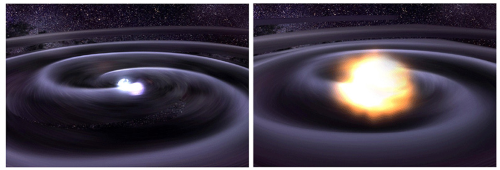
Illustration of two black holes spiralling into each other to create a larger black hole. (Courtesy: Caltech/MIT/LIGO Lab)
By Hamish Johnston
Physicists working on the LIGO gravitational-wave detectors have released more information about the merging black holes that they announced the discovery of earlier this year. Dubbed GW150914, we now know that the gravitational wave was created by the merger of one black hole that was 36 times as massive as the Sun with a smaller black hole that weighed in at 29 solar masses. The result of the merger was a black hole at 62 solar masses and a spin angular momentum of 0.67, where 1.0 is the maximum value of spin a black hole can have.
View all posts by this author | View this author's profile
Sea monsters at LIGO, how to become a ‘thought leader’ and why not string theory?
By Hamish Johnston
Have you ever wondered how the LIGO collaboration managed to tease out the tiny signal from gravitational wave GW150914 from all the background noise in its kilometre-sized detectors? Well you’re in luck because experts from the LIGO detector characterization group have written a lively piece on the CQG+ blog called “How do we know LIGO detected gravitational waves?”.
It’s packed full of fun facts; for example, did you know that detecting GW150914 is roughly the same as measuring a change in distance the thickness of a human hair between Earth and Alpha Centauri, the closest star to Earth? But be warned, the article is also full of technical terms such as “whistles”, “blips”, “koi fish” and even “Fringey the sea monster”. These are illustrated in the above graphic by LIGO physicist and artist Nutsinee Kijbunchoo.
View all posts by this author | View this author's profile
LISA Pathfinder opens the door to gravitational-wave detection in space
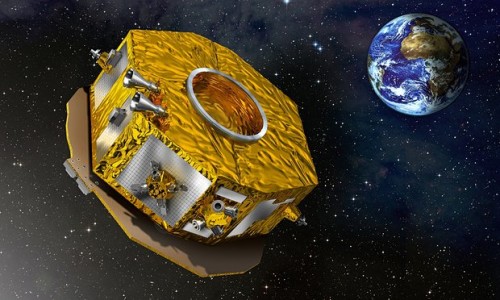
Flying high: LISA Pathfinder has overcome a major hurdle. (Courtesy: ESA)
By Hamish Johnston
2016 is shaping up to be a bumper year for physicists trying to detect gravitational waves. In February the LIGO collaboration announced the first ever direct detection of gravitational waves using two kilometre-sized detectors in the US.
Now, it looks like an even bigger detector will get permission to launch. Researchers working on the LISA Pathfinder space mission have just announced that they were able to isolate a 2 kg test mass at a special “Lagrangian point” between the Earth and the Sun. This is important because the planned LISA gravitational-wave observatory will use test masses located at three points in space (each separated by about one million kilometres) as the basis for a huge detector.
Kavli prize for gravitational-wave pioneers
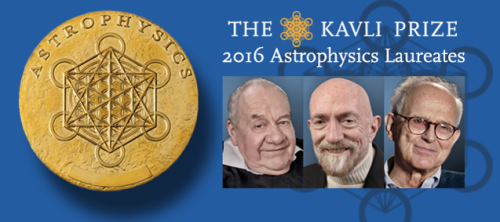
Gravitational-wave pioneers: (l to r) Ronald Drever, Kip Thorne and Rainer Weiss.
By Michael Banks
It’s been a great month for the people behind the Advanced Laser Interferometer Gravitational-wave Observatory (aLIGO), which recently discovered gravitational waves.
In early May, Ron Drever, Kip Thorne and Rainer Weiss – who co-founded LIGO – together bagged a cool $1m share of a special $3m Breakthrough Prize together with more than 1000 LIGO scientists, who shared the remaining $2m.
View all posts by this author | View this author's profile
LIGO could soon detect one gravitational wave per week
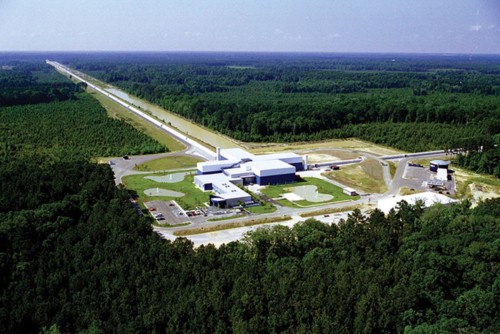
The LIGO detectors in Louisiana (above) and Washington are currently being upgraded. (Courtesy: LIGO/Caltech)
By Hamish Johnston at the APS April Meeting in Salt Lake City
I came to Salt Lake City hoping to glean a few golden nuggets of information about what future gravitational-wave detections we can expect from LIGO. What I found is that the collaboration is as tight-lipped as ever about discussing potential results. That’s fair enough and I understand the caution. However, I was hoping that the researchers would have loosened up a bit after their February announcement of the first gravitational-wave detection and share a little more with the general public.
So, what have I learned?
Merging black holes come to Salt Lake City
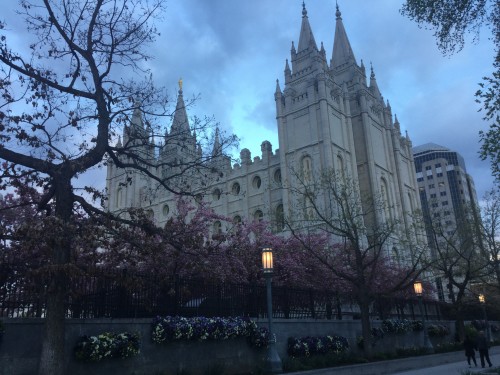
The Mormon Temple in Salt Lake City.
By Hamish Johnston at the APS April Meeting in Salt Lake City
Will the LIGO collaboration announce today that it has detected more gravitational waves? There is a session this morning at 10.45 a.m. at the APS April Meeting with the enticing name “Results from Advanced LIGO“, and I think it’s safe to say that you should get there early if you want to get a seat.
In February the LIGO announced the first ever detection of a gravitational wave, which was made while the collaboration’s two detectors were being calibrated. Now that the experiment has been running since September 2015, it will be interesting to see if the first detection was a rare event that they were lucky to see, or if LIGO will be detecting the mergers of black-hole pairs on a regular basis.
Stay tuned to for updates, and in the meantime enjoy this photograph I took of the Mormon Temple, which is across the road from the convention centre here in Salt Lake City.
